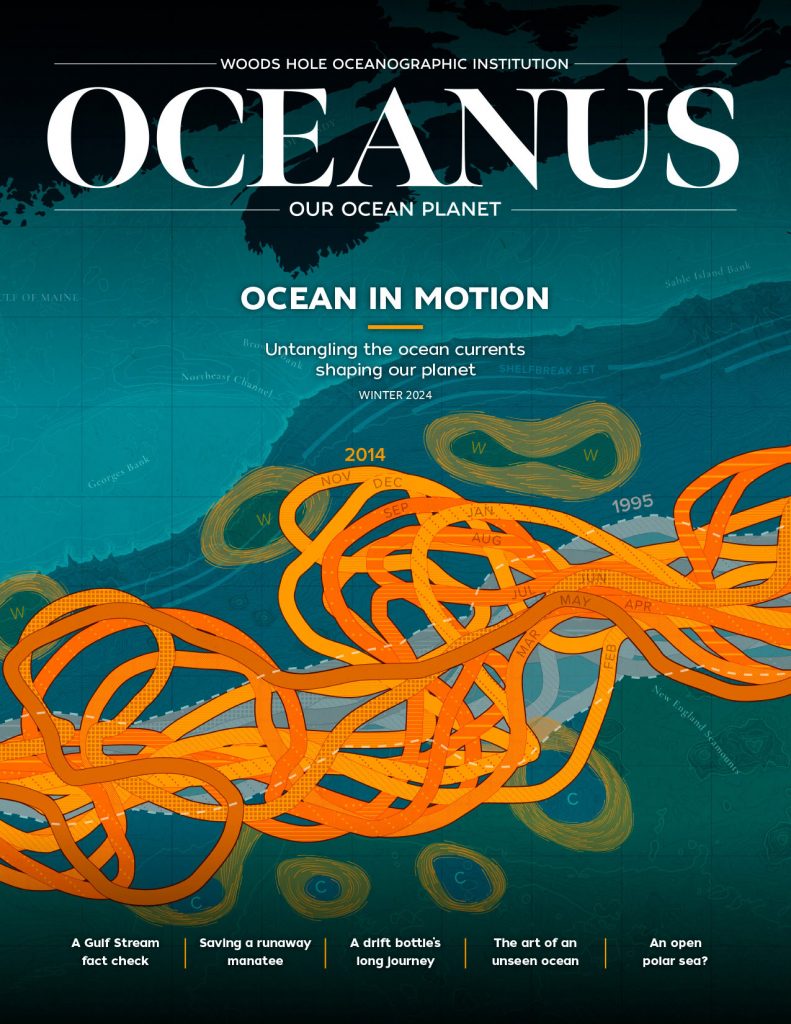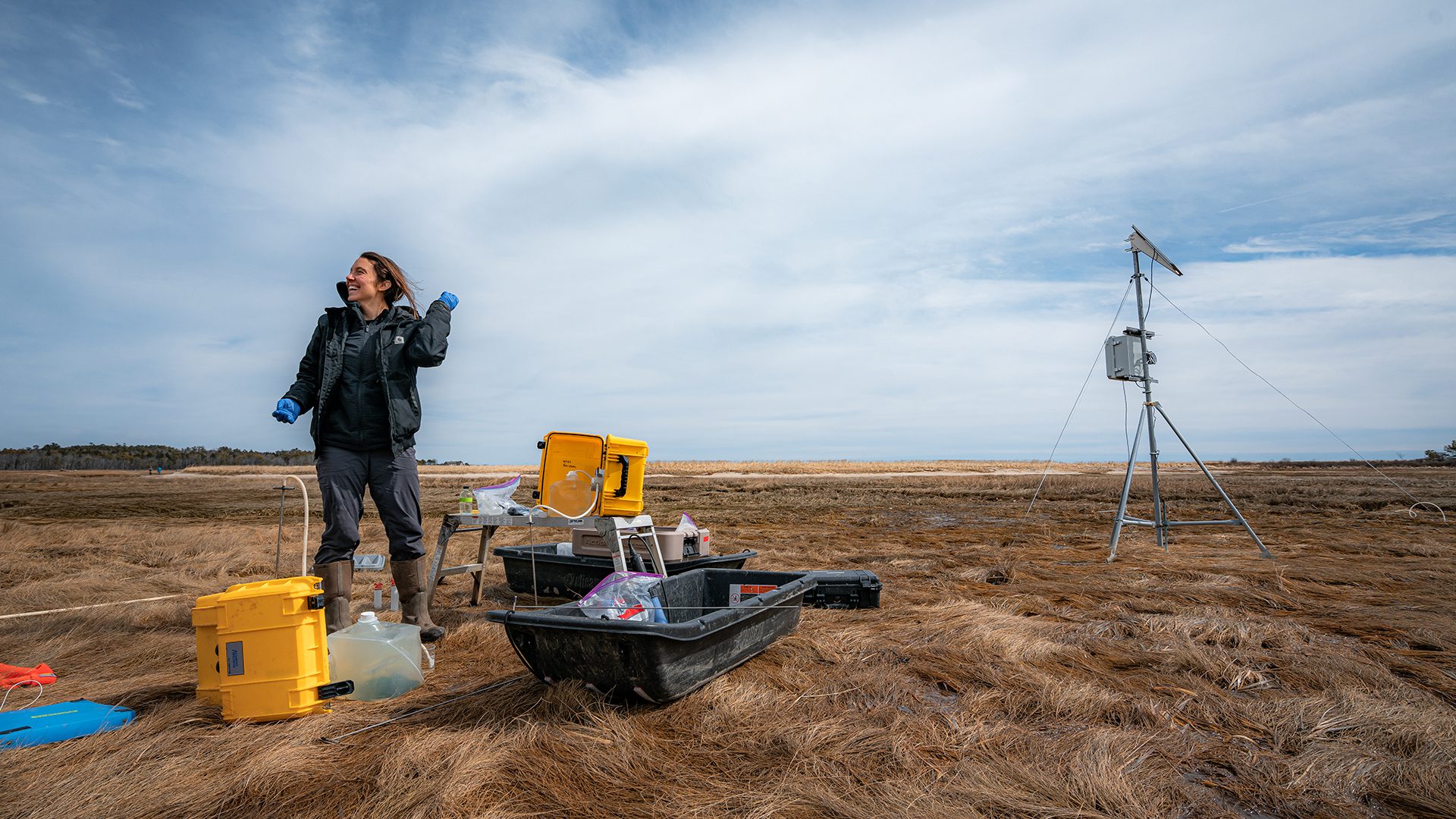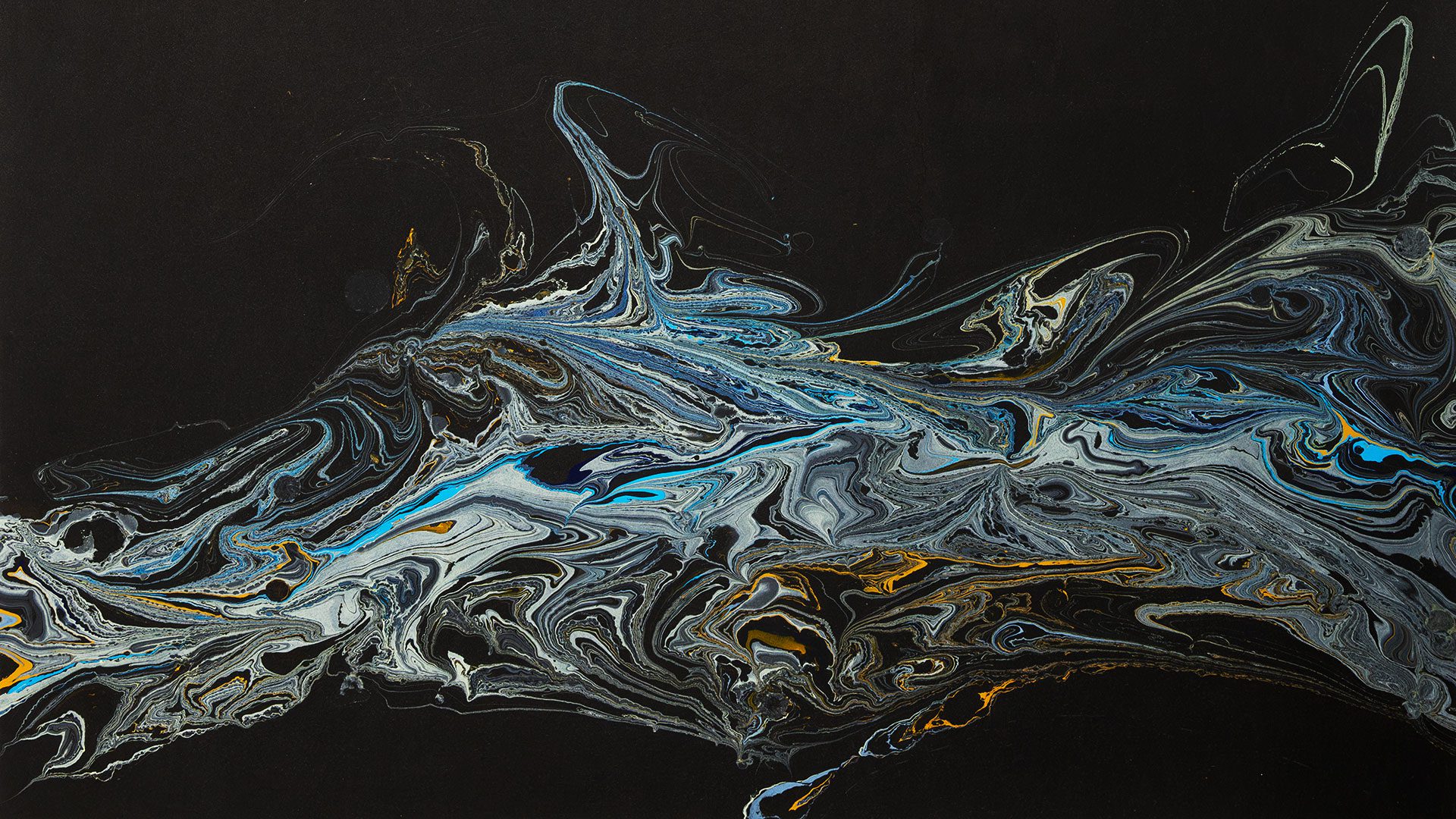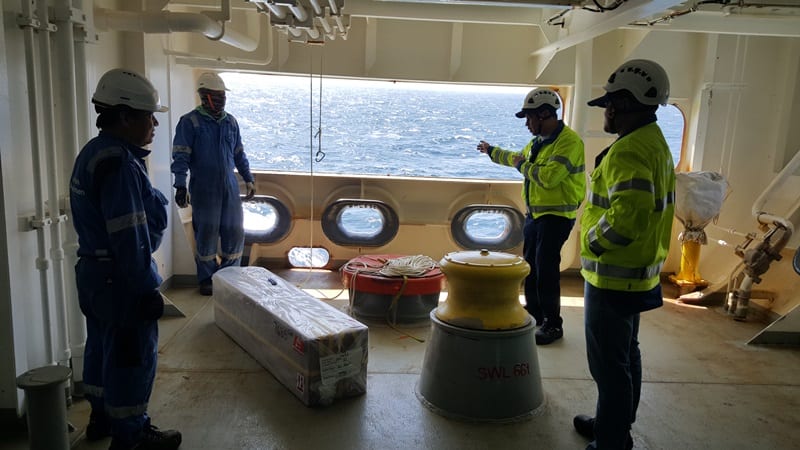
Science RoCS Initiative responds to need for increased ocean monitoring
Commercial ships are helping oceanographers deploy robotic Argo floats to keep an eye on hard-to-reach parts of the ocean
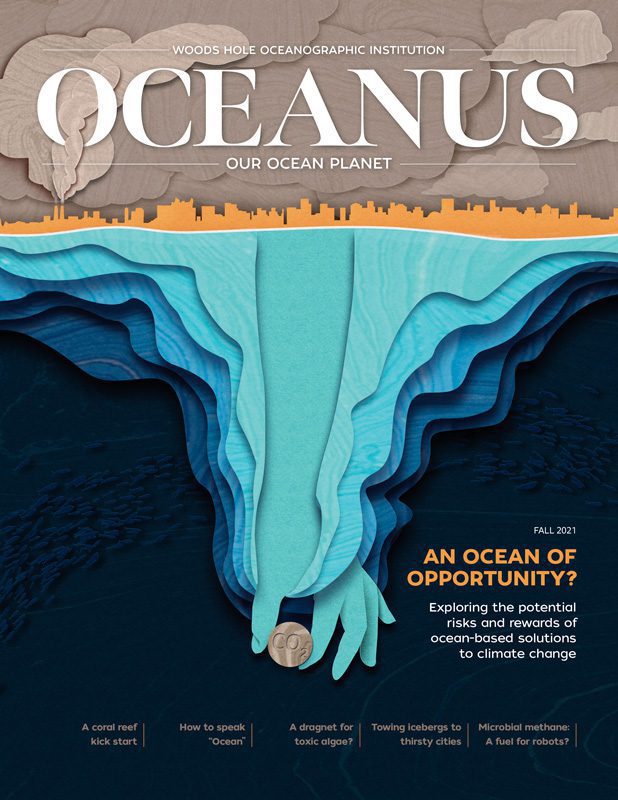 This article printed in Oceanus Fall 2021
This article printed in Oceanus Fall 2021
Estimated reading time: 5 minutes
A commercial ship's mid-May deployment of two tube-shaped Argo robotic instruments to measure the temperature, salinity, and other properties of the North Atlantic opens a new chapter in ocean monitoring. The deployment of the free-drifting instruments by a merchant vessel is the first collaboration under a new effort-the Science Research on Commercial Ships (Science RoCS) initiative-between research institutions and industry to monitor the vast and open ocean. The initiative could help to meet a long-standing need for more scientific observations and monitoring of the ocean.
Science RoCS aims to pair scientists and industry to use commercial vessels to regularly monitor the oceans, and particularly some hard-to-reach areas that may be far from normal shipping routes, according to Kerry Strom, marine operations coordinator for the Woods Hole Oceanographic Institution (WHOI), which is spearheading the effort.
Additionally, the initiative includes an innovative "RoCS box" that connects multiple scientific sensors to make installation more practical for ship owners and to make their data streams more accessible to scientists and other stakeholders onshore.
With more than 80% of the ocean unmapped, unobserved, and unexplored, according to the National Oceanic and Atmospheric Administration, Science RoCs aims to fill in some gaps in ocean monitoring.
"The ocean is vastly under-sampled. If we want to solve problems that matter to people on shore-like identifying and mitigating harmful algal blooms, or predicting how air/sea interactions will cause hurricanes to intensify, or tracking nutrient inputs that can lead to deoxygenation in regions important for fisheries-we need in situ observations of the ocean," said Magdalena Andres, the principle investigator on some Science RoCS proposals.
Andres, an associate scientist in WHOI's Department of Physical Oceanography, said that numerical modeling of the oceans can accomplish a lot, but unless you have actual observations from the ocean you don't know if the models are telling the truth. Science RoCS "can keep us honest about how the ocean is really working," she said.
She added that the observations should also complement information from satellites, whose measurements are "skin deep," and from Argo floats, which cannot sample the continental shelves and slopes, and which typically under-sample strong currents like the Gulf Stream.
"This is exactly where Science RoCS can help," she said. "By complementing existing observing programs, Science RoCS will fill in those holes so scientists and stakeholder can address societally relevant problems using integrated observing platforms hosted on commercial vessels."
The initiative "envisions a future where scientific data collection on commercial ships is the new industry standard," according to a document by WHOI and others. That data would come from regular and repeated measurements across the world's oceans, including in remote areas that are difficult for the scientific community to access.
Science RoCS, which also includes many other collaborators, builds on some other efforts and earlier plans by scientists to engage commercial "ships of opportunity" to collect ocean data. The initiative also aims to accomplish this in a more structured way than has been done previously, which would result in increased opportunities for ocean observations. In doing so, the initiative helps to cut through some red tape to more readily connect scientists with the commercial shipping industry.
"Our dream is to have commercial ships built with a suite of scientific sensors appropriate for their trade routes," said Strom.
She noted that upcoming Science RoCS projects planned for this summer include deploying from commercial vessels more Argo floats, installing a plankton recorder on a vessel that has a round-the-world voyage route, and also installing on a ship an instrument that measures the partial pressure of carbon dioxide (pCO2).
With ocean-going research vessels worldwide estimated at less than 100 and with more than 50,000 commercial ships on the ocean at any given time, "it will be a game changer" to have sensors on more vessels, Strom said. "Imagine what we could accomplish in terms of science advancement with even just a one percent increase in ocean monitoring."
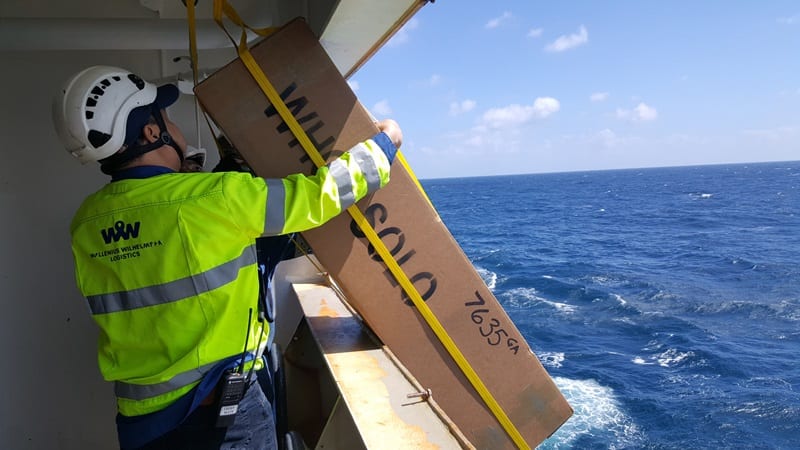
A crew member deploys an Argo float from the side of the ship. Once it enters the water, the biodegradable cardboard box quickly decomposes. (Photo courtesy of Capt. Erwin A. Augusto, Master of m/v Tijuca)
"Helping to turn commercial vessels into integrated observing platforms is a lot of work, but the payback in terms of science advancement is huge," said Andres. "Interactions with commercial vessels are one way in which we can drive science forward."
Strom, whose background includes working in commercial shipping, said that the collaboration between scientists and industry has to be beneficial to both parties to succeed.
"It can't be a one-way street. Whatever Science RoCS does with industry has to benefit company sustainability directives as well," she said. "With more sensors out there on the oceans, we can more accurately model weather and currents, which can help with ship safety and save on fuel, carbon emissions, time, and money."
That perspective was one of the reasons why the shipping company Wallenius Wilhelmsen was eager to collaborate on Science RoCS' initial effort by deploying two Argo floats, on May 20 and 21, from the company's merchant vessel Tijuca. Strom said that the initiative wanted to start with something simple to get its feet wet, before getting involved with ship retrofits or other complex efforts. The Argo floats, which just need to be deployed into the ocean within a general area, fit the bill, she said.
"It makes sense for us to facilitate research into ocean currents, because that enables us to make our operations safer and more efficient," said Roger Strevens, vice president of sustainability for the company, which operates 125 vessels in 15 trade routes to six continents, and is the leader in the shipping industry's vehicle carrier segment.
Strevens said that WHOI's understanding of industry needs also was helpful. WHOI "understands what it's like to operate vessels," he said, adding that it made the collaboration work on a practical basis.
The initiative, Strom said, is part of the solution to observing and monitoring more of the world's oceans.
Strom anticipates that Science RoCS collaborations "will be the new norm" and that other companies will jump on board. "Why wouldn't they get involved?" she said. "They're already at sea. If we're paying for the instrumentation and we're not interrupting their trade, why not? They'll look like a rock star, or in this case, a 'RoCS star'."
- 'High-octane' hurricane fuel swirls in the Gulf of Mexico
- Forecasting Future Hurricanes
- Ocean science into action: Five solution-oriented stories 2021
- Sea Ahead: The game-changing ocean technologies that will transform our ability to understand-and manage-Earth's last great frontier
- MINIONs (MINiature IsOpycNal)
